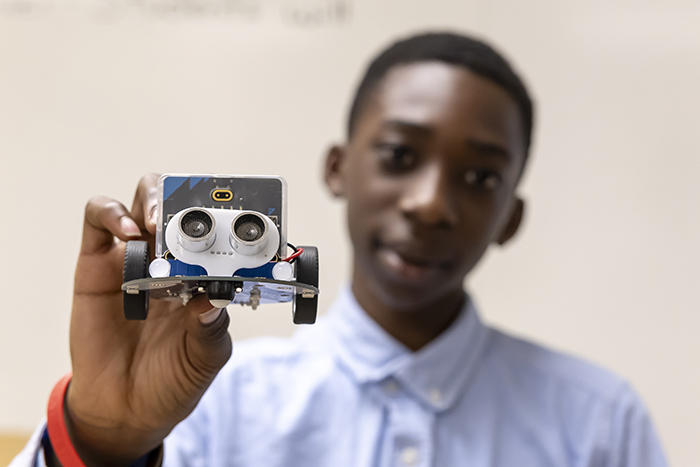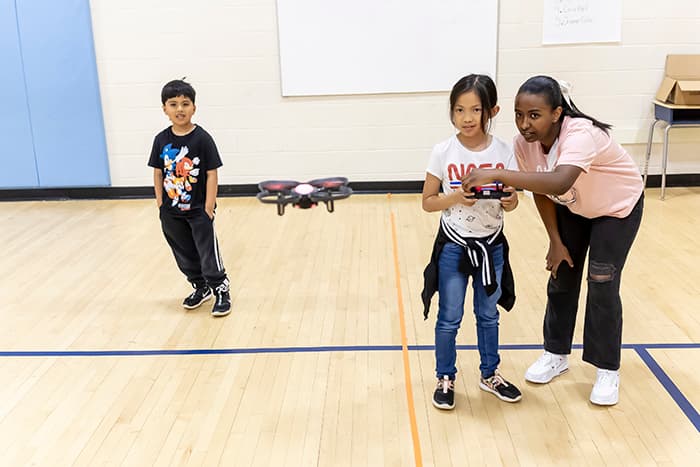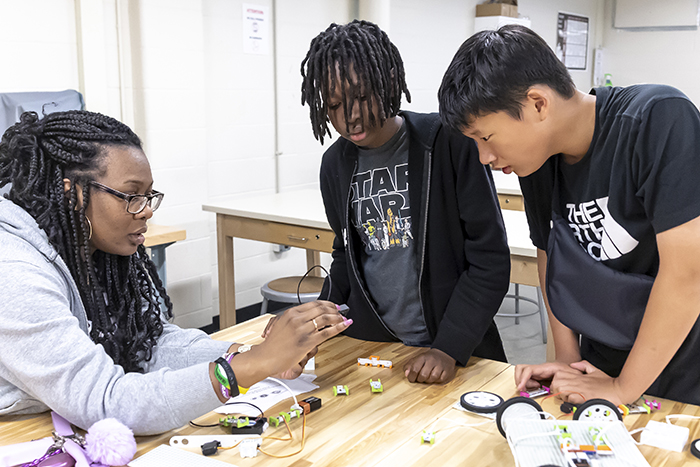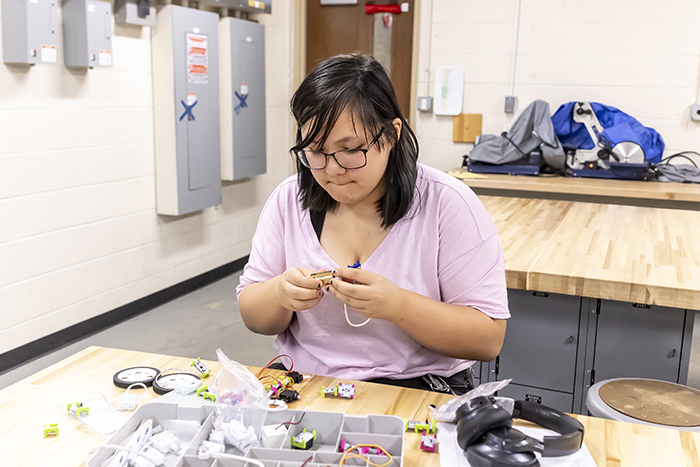Young STEAM Ambassadors Emerge at Patuxent Valley Middle School
May 20th, 2024
Last week, Patuxent Valley Middle School (PVMS) hosted a GenCyber Science, Technology, Engineering, Arts, and Math (STEAM) Night which was the culminating event to celebrate a two-year long GenCyber program fueled by a grant award from the National Security Agency (NSA).
NSA generously awarded PVMS one of the largest grant awards to an HCPSS school totaling $136,000 in 2022. Since then, PVMS has been excitedly using the funds to help introduce STEAM concepts to their middle school students and get them interested in related career pathways starting at a young age.
“The resources from this grant are allowing our students to explore potential futures and enjoy a vigorous present. This is what middle school should be like,” said Richard Smart, PVMS Principal. “I am grateful to our Gifted and Talented Resource Teacher, Monica Chelidona, for pursuing this grant opportunity which has afforded us so many opportunities, including our STEAM Night.”
At the STEAM Night, attendees could hear about STEAM careers from a panel of experts, participate in hands-on coding games, test their “piloting” skills navigating drones, learn about robotics from students on the Hammond High School robotics team and get on the STEAM Machine bus provided by the Howard County Library System.
Students and family members were also able to play around with micro:bits, which are pocket-sized programmable devices that allow students to get hands-on experience with coding and electronics. The micro:bits were purchased through the GenCyber grant as well.
“STEAM is my love. I enjoy problem-solving and debugging, and figuring out what works and what doesn’t work. I play around with different types of code, including littleBits which is more hardware-based, micro:bits which is more software-based, and drone which is a mix of both,” said seventh-grade student Pari Patel.
Another seventh-grade student, Alina Tabili, added, “STEAM is where I am most creative. I love problem-solving. It is cool translating block code to JavaScript and JavaScript to other types of code. Building things with littleBits which are magnetic is very fun. And I enjoy that I can do coding both individually and as a team.”
Many of the students who attended the event also participated in GenCyber Camp, a free program financially supported by NSA, the National Science Foundation and other federal partners. The Technology Advancement Center (TAC), formerly known as MISI, a cybersecurity nonprofit driving small business and academic engagement, hosted 100 students at the camp in June 2023 where they learned about coding, cracking passwords, identifying risks such as vulnerabilities, threats and attacks, and collecting and managing data.
“The camp was really fun because I learned more about STEAM but in a fun way and got to interact with the GenCyber staff and other students,” said seventh-grade student David Oluwabuyi.
In addition to these opportunities, about 20 students have been participating in an after-school STEAM intramural club led by PVMS Science Teacher Erin Ryan. “They are learning how to use programming pieces called littleBits, which are individual pieces that link together and have different functions, whether it’s an accelerometer that will measure how fast something is moving or a temperature meter or a simple counter,” said Ryan. “The students link the littleBits together to a program on the computer where they can also do some coding.”
As a result of this continued exposure to STEAM concepts, many of the students have taken on the role of STEAM ambassador at PVMS based on their interest in teaching and mentoring others. At the recent STEAM event, many of these students led different activities and taught other students and their family members how to use different technological devices.
“Our job in middle school, starting so early with these students, is to develop a passion for STEAM possibilities. These skills will translate well to the careers our students pursue,” said Chelidona. “The area we are in is a hub for so much technology. I think of STEAM not just as Cyber or Computer Science, but STEAM can also relate and connect to so many other fields of study, including the health sector, arts and education. It continues to grow and be an essential part of everyone’s life, especially this generation.”
Students who have participated in the GenCyber program have shown an increased interest in pursuing cybersecurity career paths, and have the option to participate in the Cybersecurity Networking Career Academy at the Applications and Research Laboratory as high school students.
“I have liked STEAM since the fifth grade and the exposure we have received throughout middle school has been really inspiring to kids who don’t quite know yet what they want to achieve in their future career,” said seventh-grade student Aishu Sreethran. “It has inspired me to do something in STEAM when I am older especially since society is evolving to be more technology based.”
Another seventh-grade student, Colin Macomber, added “With the increasing focus on technology in our economy, there is greater opportunity for more STEAM-related jobs. Our interest and passion in this field has greatly grown due our exposure to these concepts and my own interest in being more inventive and creative has been boosted through these programs.”
 HCPSS
HCPSS



